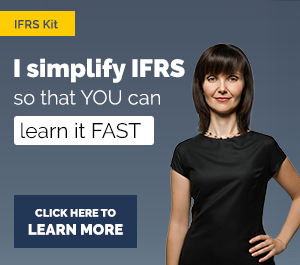IFRS 9 Financial Instruments
International Financial Reporting Standard 9
Overview of IFRS 9
- Issued: in 2009; followed by amendments
- Effective date: 1 January 2018
- It replaced IAS 39 Financial Instruments: Recognition and Measurement.
- What it does:
- It prescribes the rules for recognition, measurement (including impairment), derecognition of financial instruments and hedge accounting.
- It classifies financial assets into 2 categories:
- Financial assets measured at amortized cost;
- Financial assets measured at fair value. This category has 2 subcategories:
- Financial assets measured at fair value through profit or loss;
- Financial assets measured at fair value through other comprehensive income.
- The classification of financial assets is performed based on two tests:
- Business model test; and
- Contractual cash flow characteristics test.
- IFRS 9 classifies financial liabilities into 2 categories:
- Financial liabilities at amortized cost; and
- Financial liabilities at fair value through profit or loss; with 2 subcategories:
- Held for trading;
- Designated at FVTPL upon initial recognition.
- IFRS 9 describes requirements for subsequent measurement and accounting treatment for each category of financial instruments.
- It presents the rules for derecognition of financial instruments, with focus on financial assets. It contains the derecognition decision tree to assist in assessment of derecognition criteria.
- It contains the requirements related to impairment of financial assets. It describes the expected credit loss and both general and simplified approach to implementation of expected credit loss model.
- It deals with identification and accounting for embedded derivatives.
- It contains the guidance on hedge accounting. It specifies the accounting treatment for 3 types of hedge relationships:
- Cash flow hedge;
- Fair value hedge;
- Hedge of a net investment in a foreign operation.
- It contains appendices with definitions and application guidance.
Articles about IFRS 9
- IFRS 9 Financial Instruments Explained (2025): Full Guide + Free Practical Checklist
- Financial Instruments in general:
- Specific transactions related to financial instruments:
- How new impairment rules in IFRS 9 can affect you
- Measurement of ECL: probability of default vs loss rate approach - learn about two most common methods applied when measuring ECL, their pros and cons and illustrative examples
- How to measure probability of default - this article describes a few methods of measuring probability of default (PD) and contains my personal recommendation for external help if you need (discounts for CPDbox subscribers and readers)
- How to calculate bad debt provision under IFRS 9 - here, you will find step-by-step process of determining the default rates and calculating the provision under IFRS 9
- How to account for employee loans (below-market interest rate)
- How to account for intercompany loans? Find out what to do when the documentation is missing, the loan is at no interest, no specified repayment date...
- Expected credit loss on intercompany loans - learn to apply the newest ECL model
- Example: ECL model on interest-free on-demand loan
- How to account for compound financial instruments (IAS 32)
- How to account for debt factoring/selling of receivables
- How to Account for Cryptocurrencies in line with IFRS - learn why they are NOT a financial instrument.
- Hedge accounting:
Questions and Answers
- Should we apply ECL model if we only have trade receivables?
- Case study: Application of IFRS 9 to cash flow hedges (interest rate swaps) - this is an example of a professional advice of our Helpline team (our full answer)
- How to calculate the impairment loss on intercompany loans?
- Can you classify variable-interest loan with collaterals at amortized cost?
- How to present a loan with breached covenants? Is it current or non-current?
- How to account for income from loan application fees?
- How to account for financial guarantees?
- How to test hedge effectiveness?
- What is the difference between a contract asset and an account receivable?
- How to account for investment gold under IFRS?
- Non-controlling interest in a private company- how to account for your investment that is not publicly traded?
- Accounting for loan refinancing fees- should you recognize the refinancing fee in profit or loss?
- Accounting for gain or loss on sale of shares classified at FVOCI
- Measurement of trade receivables under IFRS 9- how do you classify trade receivables and how do you measure them initially, especially when they are not interest bearing?
- Are income tax advances financial instruments?- should you apply IFRS 9?
Other Resources
- IFRS Kit - learn IFRS in 150+ videos, 150+ excel case studies, quizzes, certificates
- Expected Credit Loss for Accountants - highly specialized course focused on ECL under IFRS 9 with step-by-step example related to trade receivables, many practical insights included.


